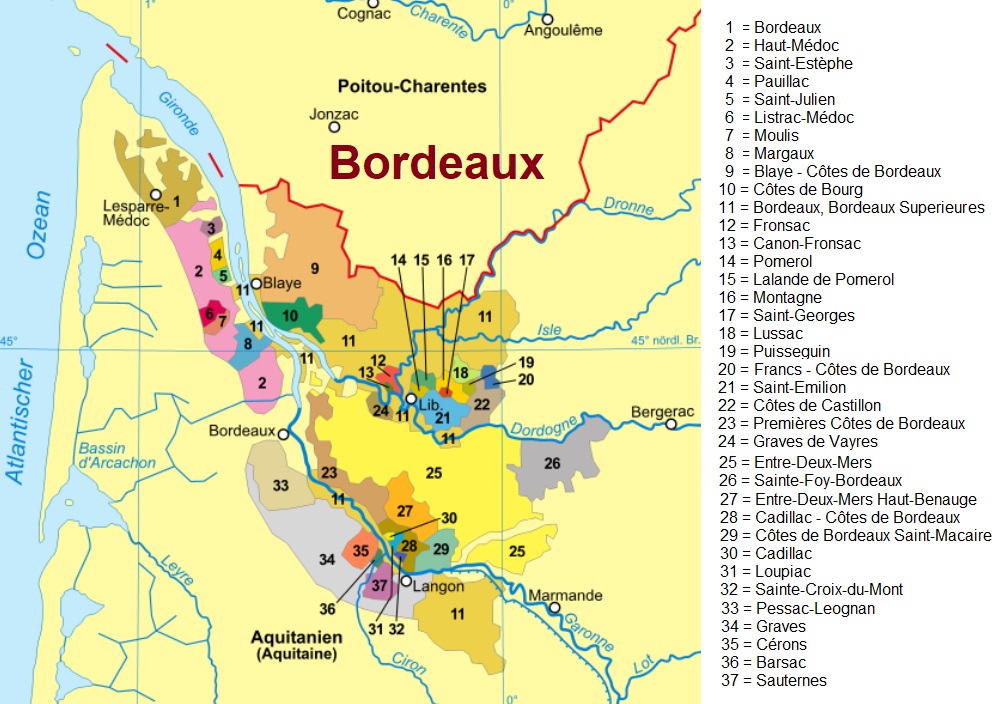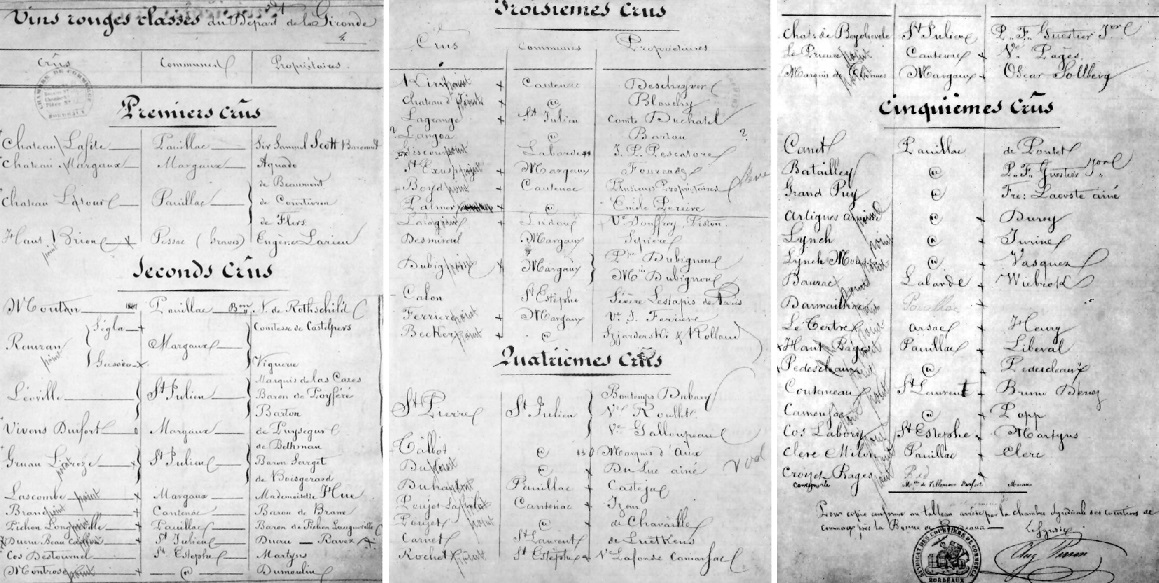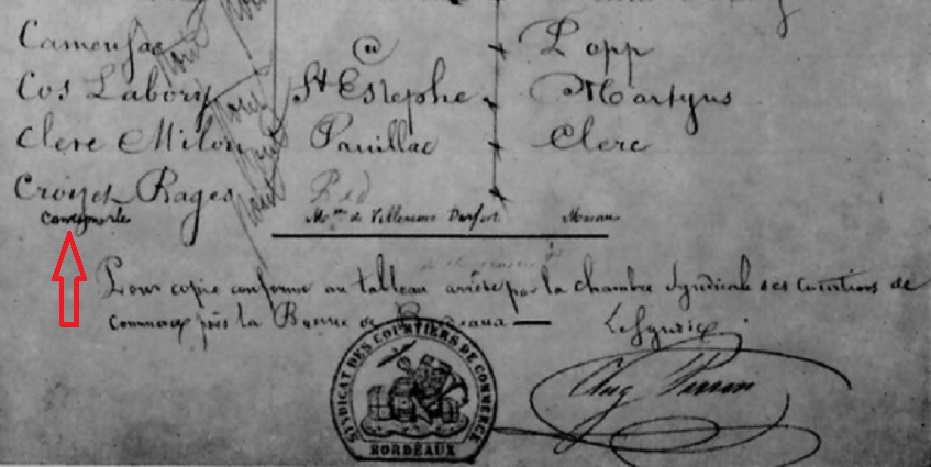Results
2,284 Results
Loading more Results ...
Loading more Results ...
| Médoc AOC |
Description to Médoc AOC
The wine-growing area belongs to the French region of Bordeaux; the name means "middle land". It is located north-west of the city of Bordeaux on the triangular peninsula between the Gironde estuary, formed by the confluence of the Garonne and Dordogne rivers, and the Atlantic Ocean. Around 70 kilometres long and 5 to 12 kilometres wide, the strip of land dominated by vineyards is interrupted by pastureland, scrubland and polders (floodplain). The area is divided into two regional appellations (Bas-Médoc and Haut-Médoc) and six communal appellations within Haut-Medoc with around 16,000 hectares of vineyards. Médoc is probably the most famous appellation in the Bordelais and also one of the most important and best red wine regions in France and the world.

History
Viticulture came to this region relatively late. In the 17th century, under the guidance of Dutch dam and hydraulic engineering specialists, the coasts were straightened, swampy areas drained and streams regulated. This is why the area was called "La Petite Hollande" for a long time. As there was no viticulture in the area at that time, the Dutch bought wines from the "Bordeaux hinterland", which was known as the Haut-Pays and the wines from there as "Vin de Haut" or "Hooglansche Wijn" in Dutch. Later, many vineyards were planted or small areas were acquired and combined into larger estates, including by the famous Ségur family. Médoc has particularly good conditions for viticulture. These are the mild climate, the very poor and deep gravel soil in many places, which forces the vines to drive their roots deep into the ground, and the good drainage in the soil. Despite the close proximity to the Atlantic, the climate is not humid, as the many pine forests provide excellent protection against winds and rain from the west.
Appellations
Médoc is divided into the northern area Bas-Médoc (usually referred to somewhat confusingly as Médoc, as this does not refer to the entire area) with 5,600 hectares and the southern area Haut-Médoc with 4,600 hectares of vineyards (the sizes refer to the two appellations without the six communes listed below). The border runs from Saint-Seurin-de-Cadourne to the north of the commune of Saint-Estèphe. Haut-Médoc begins at the southern corner of the commune of Blanquefort, which forms the northern border with the Graves area. Both areas are also entitled to their own appellation. They are characterised by very different soil types. In Haut-Médoc, the wines are categorised somewhat higher due to the gravelly soil and have more race and finesse. The six famous communes of Margaux, Moulis, Listrac-Médoc, Pauillac, Saint-Estèphe and Saint-Julien form their own appellations within Haut-Médoc.
The wines from the other communes are labelled "Haut-Médoc", the wines from Bas-Médoc simply "Médoc" or rarely "Bas-Médoc". They are made from the typical Bordeaux blend grape varieties, with Cabernet Sauvignon tending to dominate in Haut-Médoc and Merlot in Bas-Médoc. However, the mix of grape varieties differs mainly depending on whether you are on the Rive droite (right bank) or Rive gauche (left bank) of the Garonne/Dordogne or Gironde. The less important white wines are mainly made from Sauvignon Blanc. Typical of the Médoc are the numerous magnificent châteaux, which also deserve this designation (as "château") from an architectural point of view. However, this is not a sign of quality, as there are also wine estates with very simple buildings where great wines are produced.
Bordeaux classification
The famous Bordeaux Class ification took place in 1855 (the reason for this and the exact procedure is described under this keyword). Out of a total of 4,000 châteaux or red wines, only 61 (the number from today's perspective) were deemed worthy of inclusion in the list. With the sole exception of Château Haut-Brion from the Graves region, only châteaux from the Médoc are included. The official presentation took place with great pomp in the presence of Emperor Napoleon III (1808-1873) on 18 April 1855 and the châteaux were grouped into five classes. Within these five classes, the wines were ranked in descending order based on the average price achieved. Château Lafite-Rothschild was at the top of the list. A facsimile of the handwritten original documents:

Ranking of the châteaux
The ranking of the châteaux at the time is shown below. In a letter from the jury to the Chamber of Commerce dated 16 September 1855, it was noted that there was no qualitative ranking or rating within a level; wines of the same level were to be considered equal. But just one month earlier, the opposite was claimed. Another argument against "equality" is that in the original list the wines were not organised alphabetically or by municipality. The simple reason was probably to avoid upsetting anyone and prevent endless disputes and protests.
Today, the class is rarely mentioned on the label, but often only "Grand Cru Classé en 1855". However, the lesser-known Deuxièmes often refer to their status in order to gain a reputation. Baron Philippe de Rothschild also took the opportunity in 1973 to document the elevation of Château Mouton-Rothschild to the first rank with the famous quote "Premier je suis, Second je fus, Mouton ne change" (First I am, Second I was, Mouton does not change) on the label designed by Pablo Picasso (1881-1973). The châteaux that are "only" classified as fourth and fifth crus in particular usually deliberately leave this off so as not to make their "low" rank too obvious.

Changes since 1855
Surprisingly, there have only been two changes to the list of châteaux published in April 1855. The most well-known is the reordering of Château Mouton-Rothschild. After decades of struggle by Philippe de Rothschild (1902-1988), it was moved from second to first place. The official document was signed by the then Minister of Agriculture and later President Jacques Chirac (1932-2019). It was also decided that the five Premier Crus would not be listed in order of rank, but in alphabetical order. However, with one exception: Château Haut-Brion is the only non-Médoc vineyard to always be listed last.
The lesser-known change is that of the "forgotten" Château Cantemerle. The wines were almost exclusively exported to Holland and were hardly known in France. This estate was not even included in the list published in April and was only added at the end in December. This can be easily recognised by the much smaller font and a different font (arrow). They simply did not want to confuse the whole order.

Compared to 1855, however, there have been other, sometimes considerable, changes at many wine estates to this day. Most of the châteaux have changed considerably in terms of vineyard area and size over the course of time. In some cases, there has been quite extensive growth. In contrast to the classification in Saint-Émilion, for example, the boundaries of the Médoc vineyards can change without this having any influence on the classification or ranking. The only requirement is that the plots must be located within the appellation. What counts here is the reputation of the wine estate and not the quality of the location or vineyards. The name of the winery is regarded as an unchanging quality feature and trademark, so to speak. However, this continuity actually applies to most châteaux.
Number of châteaux - 59 or 61
There is sometimes confusion about the number of "61 classified châteaux", as the original list from 1855 only contains 59 names. The reason for the difference is the division of ownership and the closure of an estate. Although the former Château Léoville had already been divided into three in 1826, it was valued as one estate. The two châteaux Pichon-Longueville and Batailley were only divided into two after 1855, so they are only included once each. And Château Dubignon no longer exists; the vineyards were transferred to Château Malescot Saint-Exupéry, Château Margaux and Château Palmer.
Ownership status
There were also some name changes. Only two of the estates classified in 1855 are still owned by the same family today as they were then, namely Château Langoa-Barton and Château Mouton-Rothschild. Today, the 61 châteaux cover around 3,000 hectares of vineyards with around 20% of the Médoc production. The five Premier Cru Classé estates are "national treasures" and may not be sold to foreigners; any buyer must be French.
List of classified châteaux

The column "R" shows the order in the original list and under "Name 1855" the names at that time:
NAME OF THE CHÂTEAU |
R |
NAME 1855, REMARKS |
COMMUNITY |
Premier Cru Classé (5) |
|||
| Château Lafite-Rothschild | 1 | Lafite | Pauillac |
| Château Latour | 3 | Latour | Pauillac |
| Château Margaux | 2 | Margaux | Margaux |
| Château Mouton-Rothschild | - | Mouton - was 1st winery at Deuxieme, up-ranked in 1973 | Pauillac |
| Château Haut-Brion | 4 | Haut Brion - the only vineyard outside the Médoc | Pessac-Léognan |
Deuxième Cru Classé (14) |
|||
| Château Brane-Cantenac | 8 | Brane-Cantenac | Cantenac-Margaux |
| Château Cos d'Estournel | 11 | Cos Destournel | Saint-Estèphe |
| Château Ducru-Beaucaillou | 10 | Ducru Beau Caillou | Saint-Julien |
| Château Durfort-Vivens | 5 | Durfort | Margaux |
| Château Gruaud-Larose | 6 | Gruaud-Laroze | Saint-Julien |
| Château Lascombes | 7 | Lascombe | Margaux |
| Château Léoville-Barton | 4 | Léoville - rated together with Las-Cases and Poyferré | Saint-Julien |
| Château Léoville-Las-Cases | 4 | Léoville - rated together with Barton and Poyferré | Saint-Julien |
| Château Léoville-Poyferré | 4 | Léoville - rated together with Barton and Las-Cases | Saint-Julien |
| Château Montrose | 12 | Montrose | Saint-Estèphe |
| Château Pichon-Longueville Baron | 9 | Pichon Longueville - was with Comtesse 1 winery | Pauillac |
| Château Pichon-Longueville Comtesse | 9 | Pichon Longueville - was with Baron 1 winery | Pauillac |
| Château Rauzan-Gassies | 3 | Rauzan-Gassies | Margaux |
| Château Rauzan-Ségla | 2 | Rauzan-Ségla | Margaux |
Troisième Cru Classé (14) |
|||
| Château Boyd-Cantenac | 7 | Boyd-Cantenac | Cantenac-Margaux |
| Château Calon-Ségur | 12 | Calon | Saint-Estèphe |
| Château Cantenac Brown | 7 | Cantenac Brown | Cantenac-Margaux |
| Château d'Issan | 2 | d'Issan | Margaux |
| Château Desmirail | 10 | Desmirail | Margaux |
| Château Ferrière | 13 | Ferrière | Margaux |
| Château Giscours | 5 | Giscours | Labarde-Margaux |
| Château Kirwan | 1 | Kirwan | Cantenac-Margaux |
| Château Lagrange | 3 | Lagrange | Saint-Julien |
| Château La Lagune | 9 | Lalagune | Ludon |
| Château Langoa-Barton | 4 | Langoa | Saint-Julien |
| Château Malescot Saint-Exupéry | 6 | Saint-Exupéry | Margaux |
| Château Marquis d'Alesme-Becker | 14 | Becker | Soussans-Margaux |
| Château Palmer | 8 | Palmer | Margaux |
| No longer exists | 11 | Dubignon | Margaux |
Quatrième Cru Classé (10) |
|||
| Château Beychevelle | 9 | Ch. de Beychevele | Saint-Julien |
| Château Branaire-Ducru | 4 | Branaire | Saint-Julien |
| Château Duhart-Milon-Rothschild | 5 | Duhart | Pauillac |
| Château La Tour-Carnet | 7 | Carnet | Saint-Laurent |
| Château Lafon-Rochet | 8 | Rochet | Saint-Estèphe |
| Château Marquis-de-Terme | 11 | Marquis de Termes | Margaux |
| Château Pouget | 6 | Pouget-Lassale | Cantenac-Margaux |
| Château Prieuré-Lichine | 10 | Le Prieuré | Cantenac-Margaux |
| Château Saint-Pierre | 1 | Saint-Pierre | Saint-Julien |
| Château Talbot | 2 | Talbot | Saint-Julien |
Cinquième Cru Classé (18) |
|||
| Château Batailley | 2 | Batailley - was with Haut-Batailley 1 winery | Pauillac |
| Château Belgrave | 12 | Coutenceau | Saint-Laurent |
| Château Cantemerle | 17 | Cantemerle - last place, added later | Macau |
| Château Clerc Milon | 15 | Clerc Milon | Pauillac |
| Château Cos Labory | 14 | Cos Labory | Saint-Estèphe |
| Château Croizet-Bages | 16 | Croizet-Bages | Pauillac |
| Château d'Armailhac | 8 | Darmailhac | Pauillac |
| Château Dauzac | 7 | Dauzac | Labarde-Margaux |
| Château de Camensac | 13 | Camensac | Saint-Laurent |
| Château du Tertre | 9 | La Tertre | Arsac-Margaux |
| Château Grand-Puy Ducasse | 4 | Artigues-Arnaud | Pauillac |
| Château Grand-Puy-Lacoste | 3 | Grand Puy | Pauillac |
| Château Haut-Bages-Libéral | 10 | Haut Bages | Pauillac |
| Château Haut-Batailley | 2 | Batailley - was with Batailley 1 winery | Pauillac |
| Château Lynch-Bages | 5 | Lynch | Pauillac |
| Château Lynch-Moussas | 6 | Lynch Moussas | Pauillac |
| Château Pédesclaux | 11 | Pédesclaux | Pauillac |
| Château Pontet-Canet | 1 | Canet | Pauillac |
Super-Seconds
This refers to those Deuxièmes-Châteaux that are close to or at Premier Cru level due to their outstanding wine quality. With a new classification, these would end up at the top of the list. Experts argue about the list, but the following are frequently mentioned: Cos-d'Estournel, Ducru-Beaucaillou, Gruaud-Larose, Léoville-Las-Cases, Montrose, Pichon-Longueville Comtesse, Pichon-Longueville Baron and Rauzan-Ségla. According to experts, Château Grand-Puy-Lacoste and Château Lynch-Bages (5th place) and Château Palmer (3rd place) deserve 2nd place.
Further information
In France, there is a bewildering variety of classification systems for wines, vineyards and appellations. This is even the case within a single region, particularly in Bordeaux. In addition to Médoc, these include Graves, Saint-Émilion and Sauternes. There is a consistent system in Burgundy. See also under Grand Cru and quality system.
Map: By Domenico-de-ga from Wikipedia, CC BY-SA 3.0, Link
Modifications from the original by Norbert F. J. Tischelmayer 2017
Facsimile Bordeaux classification: six amis
Napoleon III: by Adolphe Yvon - Walters Art Museum, Public domain, Link
Recent wines 88
 Château Bournac
— Bordeaux
2016 Médoc AOC Cru Bourgeois
14.00 €
Château Bournac
— Bordeaux
2016 Médoc AOC Cru Bourgeois
14.00 €

 Le Temple de Tourteyron
— Bordeaux
2021 Médoc AOC Cru Bourgeois
15.00 €
Le Temple de Tourteyron
— Bordeaux
2021 Médoc AOC Cru Bourgeois
15.00 €

The most important grape varieties
More information in the magazine
- Good Bordeaux doesn't have to be expensive! Crus Bourgeois
- Château Laujac Laujac 1996, Cru Bourgeois, Médoc, Bordeaux, France
- Françoise et Stéphane Dief Clos Manou 2010, Médoc, Bordeaux, France
- Château Bécade Listrac 1996, Médoc, Bordeaux
- Château Rollan de By Médoc 1996, Bordeaux
- Liv-ex Power 100: Bordeaux The number of brands in the top 100 has fallen to a new low
- Château Léoville Barton Saint Julien, 1997 Bordeaux, France
- Château Latour à Pomerol Latour à Pomerol 1981, Pomerol, Bordeaux, France
- Château Pichon Longueville Baron Les Tourelles de Longueville 1996, Pauillac, Bordeaux, France
- Château Beychevelle Beychevelle 2000, Saint Julien, Bordeaux, France

